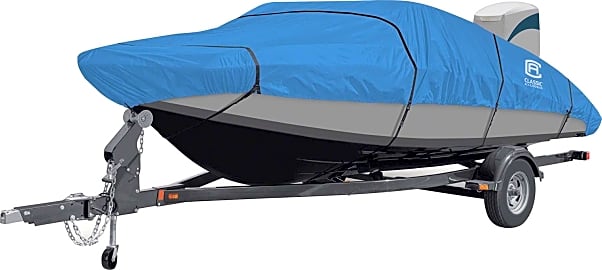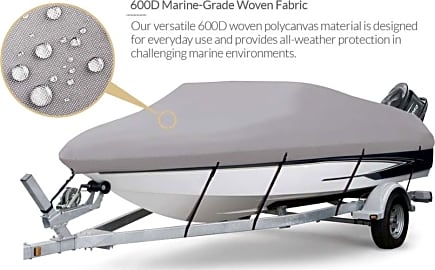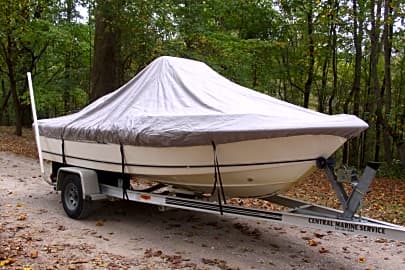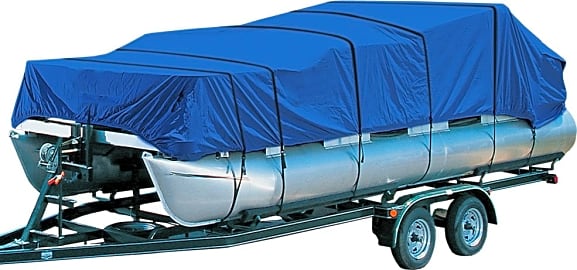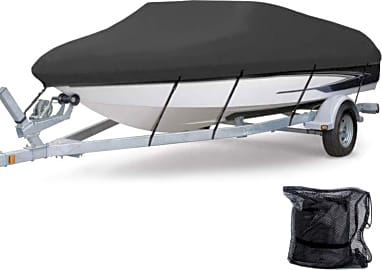The 10 Best Boat Covers

This wiki has been updated 35 times since it was first published in June of 2016. According to the old saying, the two best days in the life of a boat owner are the day the vessel is purchased and the day it’s sold. If you disagree with that sentiment (as we do), then you probably get a great deal of pleasure from your watercraft. If you're looking for a way to protect your investment while it's in transit or storage, consider sheltering it with one of these covers. When users buy our independently chosen editorial choices, we may earn commissions to help fund the Wiki.
Editor's Notes
February 16, 2020:
Chose to pull the MSC Marine off the list due to numerous reports that it fails to prevent moisture buildup, leading to mold issues and often staining the boat. We eliminated the Windstorm by Eevelle for similar reasons, noting its poor durability when exposed to the elements. We also removed the PrimeShield Waterproof because it is no longer available.
The Vortex Grey appears to be a great value, as it can be used for storage, mooring and trailering and does a good job protecting the boat from water. We moved this item up a bit.
All three items we’ve added offer dependable resistance to precipitation and sunlight. Users note that while the elastic hems of most models tend to lose elasticity over time, the edges of the Classic Accessories Stellex retain their flexibility well. The RVMasking Full comes with a motor cover, which many people seem to appreciate.
Special Honors
Mr. Shrinkwrap Transhield These shrink wrap covers come in a range of sizes and styles for use with different types of boats. They’re designed to last for several years, with a thick design and a soft fabric liner. They provide an exceptionally tight fit, and they can be used for storage or transport. mrshrinkwrap.com
Carver Styled-To-Fit Carver allows you to choose between several types of fabric, from UV-resistant marine acrylic to heavy-duty polyester that repels water effectively. The camouflage option is a nice choice for fishermen and hunters, and all these weather-resistant models are made in the United States. carvercovers.com
Why Every Boat Owner Needs A Boat Cover
Boat covers are a necessity that can actually save you money in the long run.
Ask any boat owner and they'll say boats are expensive. Buying the boat however, isn't always the most expensive aspect of boat ownership. It's the maintenance that really adds up over time. Because of this, many owners may look at a boat cover and think it is just one more unneeded accessory that will cost them money. The truth though, is quite the opposite. Boat covers are a necessity that can actually save you money in the long run. That's because a properly-fitted boat cover helps to protect your investment in a variety of ways.
When you trailer your boat to and from the launch, it is exposed to lots of road debris, including small rocks, bits of asphalt, dust, dirt, sand, and other particulate in the air. All of these are abrasives that can wear your gel coat down over time or cause small scratches. Some stones may even be large enough to cause dents in the fiberglass. Keeping a cover over your boat when you trailer it can help to prevent these things from happening.
Even when your boat is just sitting in the driveway or attached to the dock behind your home it can benefit from a cover. Constant sun exposure can cause the fiberglass deck, wood trim, cushions, and other parts of the boat to become brittle over time, eventually leading to them cracking or deteriorating in other ways. It can also cause cushions, Bimini tops, and any other fabric to fade, losing their vibrant color. Since a boat cover helps to prevent these things, it will not only keep your boat looking nicer, but also extend its lifespan and help it retain a higher resale value.
If you are like most of us, you only get two days off a week, one of which is usually spent running errands. This means your time to actually use and enjoy your boat is often limited. When you do finally get a day to take her out for a spin, the last thing you want to do is spend hours sweeping out the dead bugs and fallen leaves or branches that have collected inside of it. Let alone scrubbing the bird poop off the deck. If you keep your boat covered between uses, all of these worries will be a thing of the past. So, when you want to take the boat out, you simply hop on and go.
If all of this wasn't enough, boat covers also help to prevent casual theft of electronics, fishing equipment, and other accessories you may leave in the vessel when not in use. That's pretty important considering that these are some of the most common things stolen from boats.
Choosing The Right Boat Cover
When picking out a boat cover, the first thing you need to decide is if you want a trailering or storage cover. Storage covers don't fit as tightly, since they aren't made to be used when towing your boat to the launch. Instead, they are designed to protect boats when at anchor, tied to a dock, or sitting on a trailer at your house. They can be as simple as a blue tarp or a fully-framed shelter. Storage covers have their downsides though. Since they generally aren't tight fitting, they won't protect a boat as well from debris nor keep rodents and other pests out. For this reason, we always recommend getting a trailering cover. They offer all of the benefits of storage cover, without any of the drawbacks.
It also needs to be UV- and water-resistant, but still offer some breathability to prevent the build up of moisture inside of it.
It is important to get a trailering cover that fits your boat snugly. This means you need to measure the beam and center line length, so you know exactly how big of a cover to purchase. One that is too small won't do the job, and one that is too large will have extra fabric, which often winds up getting bundled up and becoming a haven for mold and mildew.
Pay attention to the material the cover is made from, as well. It should be lightweight enough to be easily managed by one person, but durable enough to offer a high level of protection. It also needs to be UV- and water-resistant, but still offer some breathability to prevent the build up of moisture inside of it. While there is no perfect material, some form of synthetic polyester tends to meet all of these requirements closely enough. Ideally, you should look for an acrylic- or urethane-coated variety, or a pigment- or solution-dyed one.
Two Common Boat Cover Misconceptions
Many people believe that if they keep their boat in a storage facility or garage, then there is no need for a cover. This is actually untrue. Sure there may not be any debris flying around there, and hopefully no opportunist thief walking by, but that doesn't mean your boat is totally safe. Keeping your vessel in your garage or a storage facility won't protect it from rodents and other pests. There is nothing worse than a family of mice taking up residence inside your cabin or center console. Not only will they leave droppings everywhere, but they'll more than likely chew up a few wires or seat covers, as well, resulting in expensive repairs.
Another common belief is the tighter the boat cover, the better. This also isn't true, however. I know this may sound a little strange considering we have mentioned that a cover needs to fit snugly to be effective, but there is such a thing as too snug. A boat cover needs to be tight enough to prevent rain, rodents, and debris from entering, but not so tight that it prevents moisture vapors from escaping. If your boat cover doesn't allow some air to circulate, it will lead to the growth of mold and mildew. Once you have a buildup of mold in your boat, removing it is no easy task, so it's best to avoid it at all costs. There should be a very slim space between the boat and the cover where it meets the hull, unless you have purchased a model that has built-in air vents, in which case the space is not necessary.



